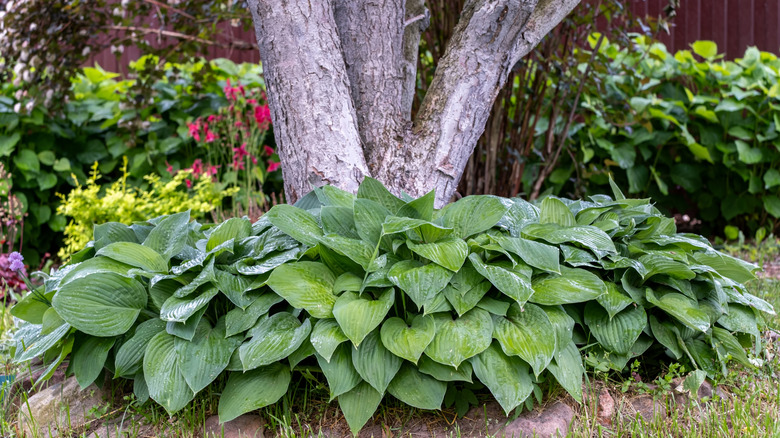One Of The Best Hosta Companion Plants Is A Gorgeous Pollinator-Friendly Ground Cover
If you grow hostas as ground cover, you'll know that they provide bold color and structure to shady gardens. There's a plant that complements hostas beautifully — softening their drama with its pastel, cloud-like blooms. If you already grow hostas, one of the best no-mess shade plants to add to your garden is the foamflower (Tiarella cordifolia). Like hostas, the foamflower is a ground cover that attracts pollinators.
While hostas (Hosta spp.) are popular and versatile plants with graceful blooms that are perfect for an allergy-friendly garden, they only bloom in summer. By contrast, the white and pink flower spikes of the foamflower appear in late spring, attracting bees, butterflies, and other pollinators to your shade garden. While foamflower's blooms invite spring butterflies with their seasonal lightness, they do not flower for long enough to hold pollinator interest on their own. After the foamflower stops producing blooms, the hostas continue to bring in pollinators with their summer flowers.
At just 6 to 12 inches tall, foamflower grows neat, compact mounds of sharply lobed foliage, often in shades of red and green. Visually, the large, distinctive leaves of the hostas will contrast well with the foamflower's frothy flowers and delicate leaves, creating a tapestry of contrasting shapes and colors when they are planted together. The effect is particularly striking when you plant foamflower between patches of hostas, mimicking the natural contrasts found in wild woodland settings. Together, they form a low-maintenance and visually balanced planting arrangement that supports pollinators from spring through summer.
How to plant hostas and foamflower together in your shade garden
Foamflower and hostas (and you as the gardener) each benefit from a companion that thrives in similar growing conditions while extending the flowering season. This is a shade garden match that looks natural right up until the first frost and keeps pollinators coming back year after year. Foamflower is a low-growing, shade-loving perennial native to moist North American forests. It's hardy in Zones 4 to 9, which crosses hostas' preferred zones of 3 to 9. Both species grow naturally beneath trees or in wooded borders, making them ideal partners for recreating a layered, woodland look in a home garden. The foamflower's shallow, runner-forming growth helps fill spaces between larger clumps of hosta, while hosta's broad leaves cover more surface area.
Plant hostas in a spot with dappled shade or morning sun to see the most flowers. Then hide your foamflower plants under your hostas dense foliage to give them the deep shade they need. Consider the soil in your garden bed carefully before planting this pairing, too. Both species thrive in soils rich in organic matter, but foamflower does not tolerate drought and prefers well-drained to moist soil, while hostas will make do with good drainage alone. Thankfully, neither plant tolerates truly soggy soils. Looking for more plants to boost the woodland vibe under trees or on slopes in your backyard? Foamflower is also an underrated companion ground cover that looks gorgeous next to bleeding hearts. Take the opportunity to add even more color to your shade garden.

